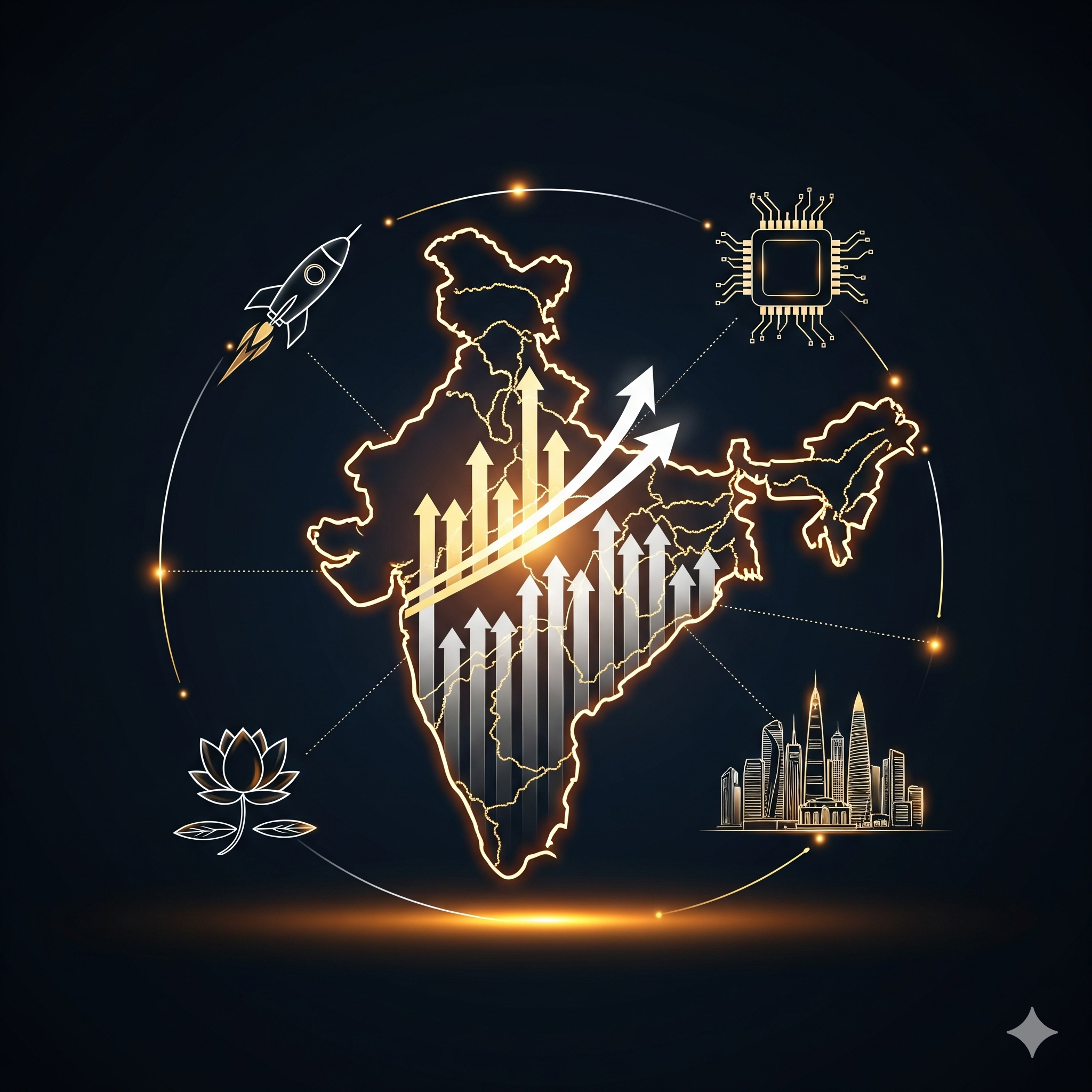Introduction
Economic reforms in India represent one of the most significant turning points in the nation’s history since independence. Initiated in 1991 under the leadership of then Prime Minister P. V. Narasimha Rao and Finance Minister Dr. Manmohan Singh, these reforms marked the transition from a protectionist, state-dominated economy toward a liberalized, market-oriented system. The reform package—often described as the LPG model, standing for Liberalization, Privatization, and Globalization—was not merely a set of policy measures to tackle the balance of payments crisis of 1991 but also a structural shift intended to integrate India into the global economy. Over three decades later, the success of these reforms continues to be debated. While India has undoubtedly achieved significant economic growth, poverty reduction, and technological advancements, critics highlight rising inequality, uneven regional development, and persistent structural weaknesses.
This essay critically examines the trajectory of India’s economic reforms, tracing their historical background, policy measures, achievements, and shortcomings, before offering a balanced assessment of their success.
Historical Background: Pre-Reform Economy
To understand the significance of the 1991 reforms, it is essential to contextualize them within India’s pre-reform economic trajectory. After independence in 1947, India adopted a mixed economy model inspired by socialist ideals, emphasizing self-reliance, state-led industrialization, and import substitution. The Planning Commission played a central role, while the government assumed control over key sectors such as steel, coal, banking, insurance, and energy.
The strategy of import substitution and protectionist trade policies initially helped develop a basic industrial base and achieve self-sufficiency in food production through the Green Revolution. However, by the late 1970s and 1980s, this model revealed deep inefficiencies. The “License Raj”—a complex system of permits and approvals—stifled entrepreneurship and innovation. Public sector enterprises, many of them monopolies, suffered from low productivity, corruption, and mismanagement. Growth was sluggish, averaging around 3.5% per annum from 1950 to 1980, a phenomenon famously termed the “Hindu rate of growth.”
The 1980s did witness some partial liberalization under Indira Gandhi and later Rajiv Gandhi, with modest trade reforms and technology imports. However, unsustainable fiscal deficits, growing external debt, and rising imports led to a severe balance of payments crisis in 1991. Foreign exchange reserves dwindled to less than three weeks’ worth of imports, forcing India to mortgage gold reserves to the IMF. This crisis created the immediate trigger for comprehensive reforms.
The Reform Package of 1991
The New Economic Policy of 1991 introduced far-reaching changes under three broad pillars:
Liberalization involved dismantling the License Raj, reducing import tariffs, deregulating industries, and allowing greater freedom for private enterprises. Industrial licensing was abolished for most sectors, while restrictions on capacity expansion were lifted.
Privatization signaled a gradual reduction of the state’s role in business. Disinvestment of public sector enterprises began, though often cautiously. The financial sector was partially liberalized, allowing greater competition.
Globalization opened the Indian economy to international trade and investment. Import duties were slashed, quantitative restrictions were reduced, and foreign direct investment (FDI) was allowed in key sectors.
The IMF and World Bank supported these measures with structural adjustment loans, making India part of the global wave of neoliberal reforms. However, unlike many Latin American countries, India implemented reforms cautiously, maintaining gradualism to balance political and social constraints.
Achievements of Economic Reforms
Accelerated Economic Growth
One of the most striking successes of the reforms has been the acceleration of GDP growth. India’s growth rate surged from around 3.5% in the pre-reform era to over 6% in the 1990s and 2000s, and above 7% in certain years of the 2000s and 2010s. India became one of the fastest-growing major economies in the world, earning recognition as an emerging power. The services sector, in particular, grew rapidly, led by information technology, telecommunications, and financial services.
Expansion of Middle Class and Poverty Reduction
Economic reforms have contributed significantly to poverty alleviation. According to World Bank estimates, the poverty headcount ratio declined from over 45% in the early 1990s to around 20% by the mid-2010s. Rising incomes, improved access to education, and targeted welfare schemes reinforced this trend. The expansion of the middle class fueled consumption, creating a vibrant domestic market for goods and services.
Integration into the Global Economy
Globalization transformed India from a relatively closed economy into an important player in global trade and investment. India’s share in world trade increased, while FDI inflows surged from negligible amounts in 1991 to over $60 billion annually in recent years. The IT and outsourcing boom established India as a global hub for software exports and business process outsourcing.
Growth of Private Sector and Entrepreneurship
The dismantling of the License Raj unleashed entrepreneurial energies. Private companies such as Infosys, Wipro, Reliance, and Tata Consultancy Services emerged as global giants. Start-ups flourished in areas like e-commerce, fintech, and biotechnology. The liberalized environment encouraged innovation, competition, and efficiency.
Technological and Infrastructure Development
Reforms facilitated rapid technological adoption, particularly in telecommunications and digital services. The mobile phone revolution, internet penetration, and digital financial services transformed India’s social and economic landscape. Infrastructure development, including roads, airports, and urban projects, received greater private and foreign investment.
Fiscal and External Sector Stability
Reforms in taxation, fiscal consolidation, and external trade helped stabilize the economy. Foreign exchange reserves grew from less than $1 billion in 1991 to over $600 billion in 2022, giving India resilience against global shocks. Inflation control and financial sector reforms improved macroeconomic stability.
Shortcomings and Criticisms
Unequal Growth and Rising Inequality
One of the sharpest criticisms of the reform era is that growth has been unevenly distributed. While urban centers and high-skilled workers have benefited, rural areas and unorganized sector workers often lag behind. Income inequality has widened, with the top 10% of the population capturing a disproportionate share of income and wealth. According to Oxfam reports, India’s inequality has reached alarming levels, raising questions about inclusive growth.
Agricultural Stagnation
Despite reforms, agriculture has not witnessed comparable dynamism. The sector still employs nearly 40% of India’s workforce but contributes less than 20% to GDP. Farmers continue to face challenges such as low productivity, fragmented landholdings, inadequate irrigation, and market volatility. Reforms largely bypassed agriculture, leaving it vulnerable to crises, as seen in farmer protests against recent agricultural reforms.
Persistence of Unemployment
Job creation has not kept pace with economic growth, leading to what scholars call “jobless growth.” While the services sector boomed, manufacturing failed to absorb surplus labor from agriculture. The informal sector still dominates employment, with limited social security and job stability. Youth unemployment remains a major challenge, raising concerns about the sustainability of growth.
Regional Disparities
Economic reforms have exacerbated regional inequalities. Southern and western states such as Maharashtra, Gujarat, Tamil Nadu, and Karnataka attracted more investment and industrial growth, while states in the northern and eastern belt such as Bihar, Uttar Pradesh, and Odisha lagged behind. This divergence risks deepening political and social divides.
Dependence on Global Economy
Greater integration into global markets has made India vulnerable to external shocks, such as the Asian financial crisis (1997), the global financial crisis (2008), and the COVID-19 pandemic (2020). Over-reliance on services exports, particularly IT, creates risks if global demand falters. Protectionist measures in advanced economies also threaten India’s export-driven sectors.
Limited Success of Privatization
Privatization has been cautious and uneven. Many loss-making public sector enterprises continue to drain resources. Political opposition and labor union resistance often slowed disinvestment. As a result, the state remains deeply involved in sectors where efficiency could be improved through private participation.
Social and Environmental Concerns
Rapid industrialization and urbanization have created new challenges. Environmental degradation, air and water pollution, and deforestation are pressing issues. Economic growth has also heightened social tensions, particularly where land acquisition and displacement have affected vulnerable communities. Critics argue that reforms prioritized growth over sustainability and equity.
Recent Developments and Reform Continuity
Economic reforms did not end in the 1990s; they have evolved through successive governments. The early 2000s witnessed further liberalization in telecommunications, banking, and infrastructure. The 2010s brought major structural reforms such as the Goods and Services Tax (GST), Insolvency and Bankruptcy Code (IBC), and digitalization drives like Digital India. The government also pursued reforms in FDI policies, banking consolidation, and labor codes.
The COVID-19 pandemic tested India’s resilience, but reforms such as the Atmanirbhar Bharat package sought to balance self-reliance with global integration. Current debates focus on balancing growth with equity, fostering manufacturing through initiatives like “Make in India,” and addressing climate change through green growth strategies.
A Balanced Assessment
The economic reforms of 1991 and their subsequent evolution represent a historic transformation. India’s economy has grown more than sixfold in size since liberalization, poverty has declined substantially, and the country has emerged as a global economic power. Without reforms, India may not have achieved its current status as the world’s fifth-largest economy.
Yet the success story is incomplete. Structural challenges—agricultural stagnation, inequality, jobless growth, and regional disparities—persist. The social safety net remains inadequate, and environmental sustainability has not been fully integrated into the growth model. The reforms have created winners and losers, raising questions about inclusiveness and long-term sustainability.
Conclusion
Economic reforms in India have undoubtedly been successful in lifting the nation out of economic stagnation and positioning it as a major global economy. They unleashed the potential of private enterprise, integrated India into global markets, and transformed technology and infrastructure. At the same time, they have exposed vulnerabilities—inequality, unemployment, regional imbalance, and environmental stress—that require urgent attention.
The real success of reforms must not only be measured in terms of GDP growth but also in terms of social justice, inclusiveness, and sustainability. The next phase of reforms must therefore focus on strengthening agriculture, boosting labor-intensive manufacturing, investing in human capital, and ensuring that the fruits of growth are equitably distributed. India’s journey since 1991 has been remarkable, but the task of building a balanced, inclusive, and sustainable economy remains ongoing.




